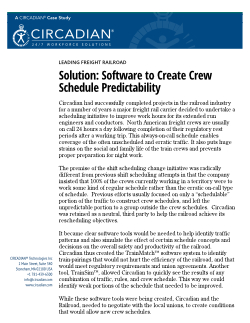CIRCADIAN® had successfully completed projects in the railroad industry for a number of years a major freight rail carrier decided to undertake a scheduling initiative to improve work hours for its extended run engineers and conductors. North American freight crews are usually on call 24 hours a day following completion of their regulatory rest periods after a working trip. This always-on-call schedule enables coverage of the often  Click image to download pdfunscheduled and erratic traffic. It also puts huge strains on the social and family life of the train crews and prevents proper preparation for night work.
Click image to download pdfunscheduled and erratic traffic. It also puts huge strains on the social and family life of the train crews and prevents proper preparation for night work.
The premise of the shift scheduling change initiative was radically different from previous shift scheduling attempts in that the company insisted that 100% of the crews currently working in a territory were to work some kind of regular schedule rather than the erratic on-call type of schedule. Previous efforts usually focused on only a “schedulable” portion of the traffic to construct crew schedules, and left the unpredictable portion to a group outside the crew schedules. CIRCADIAN® was retained as a neutral, third party to help the railroad achieve its rescheduling objectives.
It became clear software tools would be needed to help identify traffic patterns and also simulate the effect of certain schedule concepts and decisions on the overall safety and productivity of the railroad. CIRCADIAN® thus created the TrainMatch™ software system to identify train-pairings that would not hurt the efficiency of the railroad, and that would meet regulatory requirements and union agreements. Another tool, TrainSim™, allowed CIRCADIAN® to quickly see the results of any combination of traffic, rules, and crew schedule. This way we could identify weak portions of the schedule that needed to be improved.
While these software tools were being created, CIRCADIAN® and the Railroad, needed to negotiate with the local unions, to create conditions that would allow new crew schedules.
After the labor agreements were in place, a starting subdivision was chosen. Extensive traffic analysis in this territory was conducted and schedules were developed that would tell each crew when they were on call throughout the next 13 week period. One major mental leap to get to this degree of scheduling was the departure from a start-window being traditionally married to a specific train, to the introduction of the concept that any train in that window could be utilized to start the trip. By implementing this concept, CIRCADIAN® was able to increase the reliability of the 8-hr departure windows.
After a number of subdivisions were converted to this kind of scheduled operation, it was mutually agreed that long term success would best be served by converting Circadian’s expert-tool based solution into a software solution that the Railroad could operate without external help in the future. To facilitate this collaborative effort, the client provided the railroad knowledge and CIRCADIAN® the scheduling and programming skills. Thus was created the Freight Rail Crew Optimization Software (FRCOS™) which was then installed across the rail company’s system.
This included software modules for:
- Traffic analysis: Enabled creation of graphical reports that allowed the scheduler to assess the traffic either as a whole, or as a certain train in particular.
- Schedule development:Create crew shift schedules, utilizing:
- TrainMatch™ for more scheduled traffic, or
- TrainSim™ for more random traffic.
- Schedule monitoring: Enabled the scheduler to analyze how well the schedule performs in the real world, and, to determine if and which adjustments are needed.
- What-If-Scenario simulation: This module is for determining the impact of changes to the rules, traffic, or the schedule on the operation before actually implementing them. The Railroad was able to use this tool to determine feasible maximum “heldaway” thresholds in their labor negotiations.
- Various database maintenance tools: Allowed collection of historical data for future reference.
The net result was the “Landmark” achievement of incorporating human physiology into the crew scheduling protocol for the first time in the 150 year history of railroading. Instead of the debilitating, age-old practice of calling in whoever was “legal” in terms of regulatory work hours to make-up the train crews, regardless of the time of day or night, the engineers and conductors could now have regular schedules to plan their lives and their sleep around. And with the FRCOS™ software, this could now be done to accommodate the variable train flows quickly and efficiently. The net results were healthier, safer and more productive engineers, enjoying a higher quality of life. Operationally FRCOS™ has reduced the company’s costs, risks and liabilities by tens of millions or billions annually.


